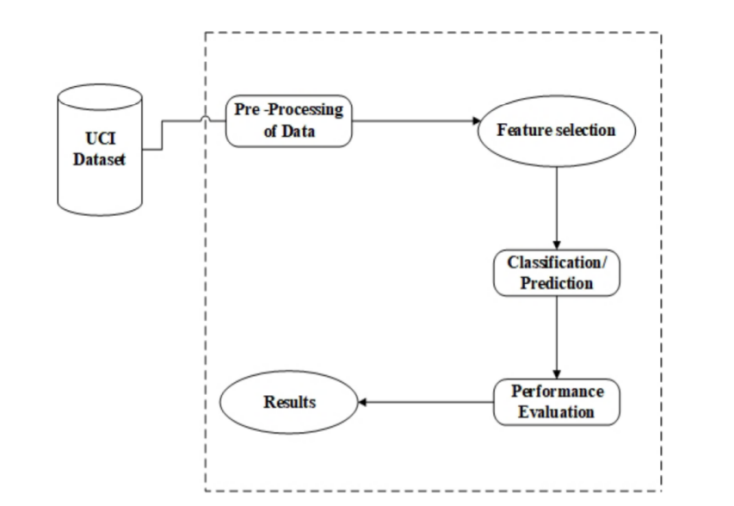An Adaptive Technique to Predict Heart Disease Using Hybrid Machine Learning Approach
Main Article Content
Abstract
cardiovascular disease is amongby far prevalent fatalities in today's society. Cardiovascular disease is extremely hard to predict using clinical data analysis. Machine learning (ML) hasproved to be useful for helping in judgement and predictions with the enormous amount data produced by the healthcare sectorbusiness. Furthermore, latest events in other IoT sectors have demonstrated that machine learning is used (IOT). Several studies have examined the use of MLa heart disease prediction. In this research, we describe a novel method that, by highlighting essential traits, can improvethe precision of heart disease prognosis. Numerous data combinations and well-known categorization algorithms are used to create the forecasting models. Using a decent accuracy of 88.7%, we raise the level of playusing a heart disease forecasting approach that incorporates a88.7% absolute certainty in a combination random forest and linear model. (HRFLM).
Article Details
References
A. S. Abdullah and R. R. Rajalaxmi, ‘‘A data mining model for predicting the coronary heart disease using random forest classifier,’’ in Proc. Int. Conf. Recent Trends Comput. Methods, Commun. Controls, Apr. 2012, pp. 22–25.
A. H. Alkeshuosh, M. Z. Moghadam, I. Al Mansoori, and M. Abdar, ‘‘Using PSO algorithm for producing best rules in diagnosis of heart disease,’’ in Proc. Int. Conf. Comput. Appl. (ICCA), Sep. 2017, pp. 306– 311.
Mrs. Monika Soni. (2015). Design and Analysis of Single Ended Low Noise Amplifier. International Journal of New Practices in Management and Engineering, 4(01), 01 - 06. Retrieved from http://ijnpme.org/index.php/IJNPME/article/view/33
N. Al-milli, ‘‘Backpropogation neural network for prediction of heart disease,’’ J. Theor. Appl.Inf. Technol., vol. 56, no. 1, pp. 131–135, 2013.
C. A. Devi, S. P. Rajamhoana, K. Umamaheswari, R. Kiruba, K. Karunya, and R. Deepika, ‘‘Analysis of neural networks based heart disease prediction system,’’ in Proc. 11th Int. Conf. Hum. Syst. Interact. (HSI), Gdansk, Poland, Jul. 2018, pp. 233–239.
Reddy, A. ., & Waheeb , M. Q. . (2022). Enhanced Pre-Processing Based Cardiac Valve Block Detection Using Deep Learning Architectures. Research Journal of Computer Systems and Engineering, 3(1), 84–89. Retrieved from https://technicaljournals.org/RJCSE/index.php/journal/article/view/47
P. K. Anooj, ‘‘Clinical decision support system: Risk level prediction of heart disease using weighted fuzzy rules,’’ J. King Saud Univ.-Comput. Inf. Sci., vol. 24, no. 1, pp. 27–40, Jan. 2012. doi: 10.1016/j.jksuci.2011.09.002.
Gadgil, K. S. ., Khampariya, P. ., & Bakre, S. M. . (2023). An Overview on the Investigation of Power Quality Problems and Harmonic Exclusion in the Power System using Frequency Estimation Techniques. International Journal of Intelligent Systems and Applications in Engineering, 11(3s), 49–62. Retrieved from https://ijisae.org/index.php/IJISAE/article/view/2531
L. Baccour, ‘‘Amended fused TOPSIS-VIKOR for classification (ATOVIC) applied to some UCI data sets,’’ Expert Syst. Appl., vol. 99, pp. 115–125, Jun. 2018. doi: 10.1016/j.eswa.2018.01.025.
C.-A. Cheng and H.-W. Chiu, ‘‘An artificial neural network model for the evaluation of carotid artery stenting prognosis using a national-wide database,’’ in Proc. 39th Annu. Int. Conf. IEEE Eng. Med. Biol. Soc. (EMBC), Jul. 2017, pp. 2566–2569.
H. A. Esfahani and M. Ghazanfari, ‘‘Cardiovascular disease detection using a new ensemble classifier,’’ in Proc. IEEE 4th Int. Conf. Knowl.- Based Eng. Innov. (KBEI), Dec. 2017, pp. 1011–1014. [9] F. Dammak, L. Baccour, and A. M. Alimi, ‘‘The impact of criterion weights techniques in TOPSIS method of multi-criteria decision making in crisp and intuitionistic fuzzy domains,’’ in Proc. IEEE Int. Conf. Fuzzy Syst. (FUZZ-IEEE), vol. 9, Aug. 2015, pp. 1–8.
R. Das, I. Turkoglu, and A. Sengur, ‘‘Effective diagnosis of heart disease through neural networks ensembles,’’ Expert Syst. Appl., vol. 36, no. 4, pp. 7675–7680, May 2009. doi: 10.1016/j.eswa.2008.09.013.

